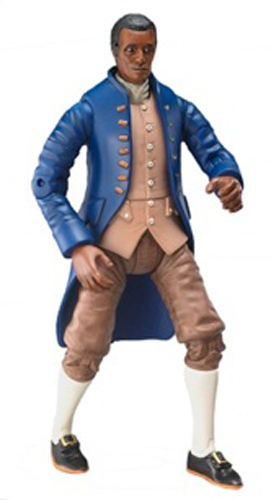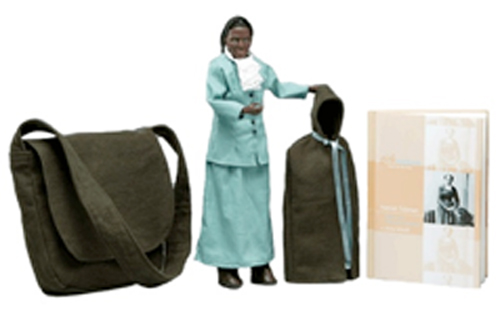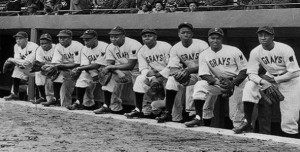This is one of the most important and significant times in Black History. To celebrate the election of a Black man as the 44th President of the United States, as well as the many achievements of Black Americans, I have selected a few of my favorite historical figures from the Museum collection to profile.

 Benjamin Banneker was a Black astronomer, clockmaker, and publisher who was instrumental in surveying the District of Columbia. He was born in Maryland on November 9, 1731. At the age of 21, Banneker’s life was changed when he saw a neighbor’s pocket watch. (Some say the watch belonged to Josef Levi, a traveling salesman.) He borrowed the watch, took it apart to draw all its pieces, then reassembled it and returned it running to its owner. Banneker then carved large-scale wooden replicas of each piece, calculating the gear assemblies himself, and used the parts to make a striking clock, the first wooden clock in the United States. The clock continued to work, striking each hour, for more than 40 years.
Benjamin Banneker was a Black astronomer, clockmaker, and publisher who was instrumental in surveying the District of Columbia. He was born in Maryland on November 9, 1731. At the age of 21, Banneker’s life was changed when he saw a neighbor’s pocket watch. (Some say the watch belonged to Josef Levi, a traveling salesman.) He borrowed the watch, took it apart to draw all its pieces, then reassembled it and returned it running to its owner. Banneker then carved large-scale wooden replicas of each piece, calculating the gear assemblies himself, and used the parts to make a striking clock, the first wooden clock in the United States. The clock continued to work, striking each hour, for more than 40 years.
Driven by this fascination, he turned from farming to watch and clock making. One customer was a neighbor named George Ellicott, a surveyor. He was so impressed with his Banneker’s work and intelligence, he lent him books on mathematics and astronomy. With this help, Banneker taught himself astronomy and advanced mathematics. Starting about 1773, he turned his attention to both subjects. His study of astronomy enabled him to make the calculations to predict solar and lunar eclipses, even correctly contradicting experts of the day, and to compile an ephemeris for his Benjamin Banneker’s Almanac, which he published from 1791 through 1796. He became known as the Sable Astronomer.
In 1791, Banneker sent then Secretary of State, Thomas Jefferson, a copy of his first almanac along with an eloquent plea for justice for Blacks, calling on the colonists’ personal experience as “slaves” of Britain and quoting Jefferson’s own words. Jefferson was impressed and sent a copy of the almanac to the Royal Academy of Sciences in Paris as evidence of the talent of Blacks. Banneker’s almanac helped convince many that Blacks were not intellectually inferior to Whites.
Also in 1791, Banneker was hired to assist brothers Andrew and Joseph Ellicott as part of a 6-man team to help design the new capital city, Washington, DC. This made him the 1st Black presidential appointee. An apocryphal story says that he worked with Pierre L’Enfant and when L’Enfant threw a temper tantrum and quit, taking his drawings with him, Banneker was able to reproduce said drawings from memory. Many historians doubt the story and claim the two men never even met. True or not, it does not diminish Benjamin Banneker’s accomplishments.
 Bessie Coleman was born on January 26, 1892, in a one-room, dirt-floored cabin in Atlanta, Texas, to George and Susan Coleman, the illiterate (unable to read and write) children of slaves. When Bessie was two years old, her father, a day laborer, moved his family to Waxahachie, Texas, where he bought a quarter-acre of land and built a three-room house in which two more daughters were born. In 1901 George Coleman left his family. Bessie’s mother and two older brothers went to work and Bessie was left as caretaker of her two younger sisters.
Bessie Coleman was born on January 26, 1892, in a one-room, dirt-floored cabin in Atlanta, Texas, to George and Susan Coleman, the illiterate (unable to read and write) children of slaves. When Bessie was two years old, her father, a day laborer, moved his family to Waxahachie, Texas, where he bought a quarter-acre of land and built a three-room house in which two more daughters were born. In 1901 George Coleman left his family. Bessie’s mother and two older brothers went to work and Bessie was left as caretaker of her two younger sisters.
Education for Coleman was limited to eight grades in a one-room schoolhouse that closed whenever the students were needed in the fields to help their families harvest cotton. Coleman easily established her position as family leader, reading aloud to her siblings and her mother at night. She often assured her ambitious church-going mother that she intended to “amount to something.” After completing school she worked as a laundress and saved her pay until 1910 when she left for Oklahoma to attend Langston University. She left after one year when she ran out of money. After befriending several leaders in South Side Chicago’s Black community, Coleman found a sponsor in Robert Abbott (1868–1940), publisher of the nation’s largest Black weekly, the Chicago Defender. There were no Black aviators (pilots) in the area and, when no White pilot was willing to teach her to fly, Coleman turned to Abbott, who suggested that she go to France. The French, he insisted, were not racists and were the world’s leaders in aviation.Coleman left for France late in 1920. There she completed flight training at the best school in France and was awarded her Fédération Aéronautique Internationale (F.A.I.; international pilot’s license) license on June 15, 1921. She traveled Europe, gaining further flying experience so that she could perform in air shows.
Coleman left Orlando, Florida, by train to give a benefit exhibition for the Jacksonville Negro Welfare League, scheduled for May 1, 1926. Her pilot, William D. Wills, flew her plane into Orlando, but had to make three forced landings because the plane was so worn and poorly maintained. On April 30, 1926, Wills piloted the plane on a trial flight while Coleman sat in the other cockpit to survey the area over which she was to fly and parachute jump the next day. Her seat belt was unattached because she had to lean out over the edge of the plane while picking the best sites for her program. At an altitude of 1,000 feet, the plane dived, then flipped over, throwing Coleman out. Moments later Wills crashed. Both were killed. Coleman had three memorial services—in Jacksonville, Orlando, and Chicago, the last attended by thousands. She was buried at Chicago’s Lincoln Cemetery and gradually, over the years following her death, achieved recognition at last as a hero of early aviation.
 Matthew A. Henson was the longtime assistant to Robert E. Peary on his expeditions to the North Pole. Henson is believed to be the first man to actually reach the pole, some 45 minutes ahead of Peary, on April 6, 1909. Henson ran away from home at the age of 11 and went to sea as a cabin boy. An able and intelligent seaman, he was hired by Peary in the late 1880s and accompanied him on his 1891 Greenland expedition. An expert with sleds and dogs and fluent in the Inuit language, Henson joined Peary off and on for nearly two decades in the quest to reach the pole.
Matthew A. Henson was the longtime assistant to Robert E. Peary on his expeditions to the North Pole. Henson is believed to be the first man to actually reach the pole, some 45 minutes ahead of Peary, on April 6, 1909. Henson ran away from home at the age of 11 and went to sea as a cabin boy. An able and intelligent seaman, he was hired by Peary in the late 1880s and accompanied him on his 1891 Greenland expedition. An expert with sleds and dogs and fluent in the Inuit language, Henson joined Peary off and on for nearly two decades in the quest to reach the pole.
Although Peary was celebrated for the achievement, he was also criticized in that era for not taking along a White man. Peary frequently praised Henson as the best man for the job, but Henson’s role was largely unrecognized for years. After reaching the pole he earned a living as a customs clerk in New York and occasionally lectured on his experiences. In 1947 Henson published his story, A Negro at the North Pole (with a foreword by Booker T. Washington and toward the end of his life he received many awards and tributes. On April 6, 1988 his body was moved from Woodlawn Cemetery in New York and re-interred next to Peary’s tomb at Arlington National Cemetery in Washington, D. C.
 Space Voyager Lt. Commander Steel Jones is a Shuttle Mission Specialist. His duties include space walks, repairing and retrieving satellites, and inspecting the exterior of the Shuttle and International Space Station (ISS). He has participated in more than 100 shuttle launches since 1981, with missions ranging from microgravity experiments to deploying satellites to transporting crew to the ISS.
Space Voyager Lt. Commander Steel Jones is a Shuttle Mission Specialist. His duties include space walks, repairing and retrieving satellites, and inspecting the exterior of the Shuttle and International Space Station (ISS). He has participated in more than 100 shuttle launches since 1981, with missions ranging from microgravity experiments to deploying satellites to transporting crew to the ISS.
 Harriet Tubman, self-emancipated slave, conductor for the Underground Railroad, Union spy, army scout and nurse. Originally called Araminta, Harriet Ross Tubman was born on the Brodas plantation, Dorchester County, Maryland. She was disabled by narcoleptic seizures throughout her life after sustaining a severe injury to her head during her youth. Despite this frailty, Tubman’s considerable strength and endurance were legendary. As a field slave, she mastered the secrets of woodcraft and navigation–skills that ensured her success as a conductor for the Underground Railroad. After her escape in 1849, Tubman returned to the South over fifteen times to rescue more than two hundred slaves. She successfully freed all of her family and never lost a single passenger during any of her escapes. More than forty thousand dollars was offered for her capture.
Harriet Tubman, self-emancipated slave, conductor for the Underground Railroad, Union spy, army scout and nurse. Originally called Araminta, Harriet Ross Tubman was born on the Brodas plantation, Dorchester County, Maryland. She was disabled by narcoleptic seizures throughout her life after sustaining a severe injury to her head during her youth. Despite this frailty, Tubman’s considerable strength and endurance were legendary. As a field slave, she mastered the secrets of woodcraft and navigation–skills that ensured her success as a conductor for the Underground Railroad. After her escape in 1849, Tubman returned to the South over fifteen times to rescue more than two hundred slaves. She successfully freed all of her family and never lost a single passenger during any of her escapes. More than forty thousand dollars was offered for her capture.
Tubman was a pivotal character in the war against slavery, first with the Underground Railroad, later with the Union army. She joined forces with the leading abolitionists of the day: William Still , Thomas Garrett, Frederick Douglass, Sojourner Truth and John Brown. After emancipation, Tubman served in the Union army as a spy, a scout and a nurse. She was the only woman in American military history to plan and execute an armed expedition against enemy forces.
After the war Tubman recounted the story of her life to Sarah Elizabeth Bradford who wrote her biography, Scenes in the Life of Harriet Tubman (1869). Using the small profits from her biography and her military pension, Tubman established a permanent home for aged ex-slaves in Auburn, New York.
 Malcolm X, Nation of Islam minister, orator, and autobiographer. Born Malcolm Little (and later also known as el-Hajj Malik el-Shabazz) in Omaha, Nebraska, on May 19, 1925. Malcolm X was the fourth of eight children of the Reverend Earl Little and his wife, Louise. Soon after Malcolm’s birth the Littles moved to the outskirts of East Lansing, Michigan. When Malcolm was six, his father died, presumably murdered by the Black Legion, a violent racist group similar to the KKK and the Little home life became more and more difficult. Louise was eventually placed in the state mental hospital, and her children were declared wards of the state. In 1941, Malcolm moved to Boston to live with his half sister, Ella. He became caught up in the nightlife of Boston and later New York. After a few years in the underworld of Harlem, selling drugs and working for call-girl services, Malcolm began a burglary ring in Boston. In 1946, at the age of twenty-one, he was arrested for armed robbery and sent to prison.
Malcolm X, Nation of Islam minister, orator, and autobiographer. Born Malcolm Little (and later also known as el-Hajj Malik el-Shabazz) in Omaha, Nebraska, on May 19, 1925. Malcolm X was the fourth of eight children of the Reverend Earl Little and his wife, Louise. Soon after Malcolm’s birth the Littles moved to the outskirts of East Lansing, Michigan. When Malcolm was six, his father died, presumably murdered by the Black Legion, a violent racist group similar to the KKK and the Little home life became more and more difficult. Louise was eventually placed in the state mental hospital, and her children were declared wards of the state. In 1941, Malcolm moved to Boston to live with his half sister, Ella. He became caught up in the nightlife of Boston and later New York. After a few years in the underworld of Harlem, selling drugs and working for call-girl services, Malcolm began a burglary ring in Boston. In 1946, at the age of twenty-one, he was arrested for armed robbery and sent to prison.
During his six years in Charlestown Prison, Concord Reformatory, and Norfolk Prison, Malcolm underwent a spiritual and intellectual transformation. While interred he corresponded with the Honorable Elijah Muhammad, the leader of the African American sect, the Nation of Islam. He converted to the Nation, attracted by its idea that Whites are devils. In prison he also undertook a rigorous process of self-education, which included copying every page of the dictionary.
Upon his release he changed his name to Malcolm X, the X representing the unknown name of his African ancestors and their culture that had been lost during slavery. After personal meetings with Elijah Muhammad, Malcolm became a minister for the Nation. From 1952 to 1963 Minister Malcolm X helped build the Nation of Islam from a tiny sect to a significant force in urban Black America. His commanding stage presence, quick wit, and erudition, combined with the authenticity of his experience as a street hustler, made Malcolm a remarkable orator and a dynamic leader.
In 1963, jealousy in the Nation of Islam over Malcolm’s increasing celebrity and Malcolm’s discovery of violations of the Muslim’s strict moral code by the Honorable Elijah Muhammad precipitated a painful and bitter split. Once out from the strict teachings of the Nation of Islam, Malcolm drifted from the primarily spiritual philosophy of the Nation to a more political Black nationalism and tentatively to a more internationalist philosophy—Pan-Africanism. Malcolm’s position on race relations in the United States at the time of his assassination on February 21, 1965 at the Audobon Ballroom in Harlem has not been resolved. His major literary achievement, The Autobiography of Malcolm X (1965), composed during the last two years of his life with the writer Alex Haley contains a montage of Malcolm’s perspectives and only invites speculation as to which direction Malcolm’s philosophy would have taken. The Autobiography, published posthumously, stands as a major twentieth-century Black literary work.





